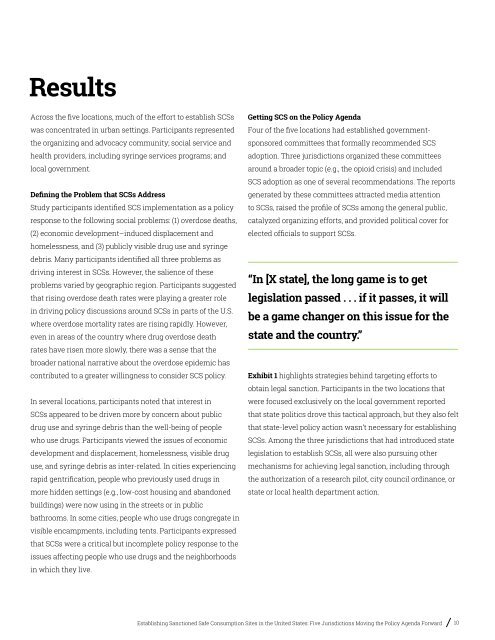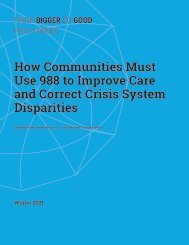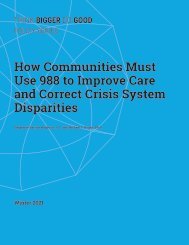Scattergood_Establishing Sanctioned Safe Consumption Sites in the United States_Web
Create successful ePaper yourself
Turn your PDF publications into a flip-book with our unique Google optimized e-Paper software.
Results<br />
Across <strong>the</strong> five locations, much of <strong>the</strong> effort to establish SCSs<br />
was concentrated <strong>in</strong> urban sett<strong>in</strong>gs. Participants represented<br />
<strong>the</strong> organiz<strong>in</strong>g and advocacy community; social service and<br />
health providers, <strong>in</strong>clud<strong>in</strong>g syr<strong>in</strong>ge services programs; and<br />
local government.<br />
Def<strong>in</strong><strong>in</strong>g <strong>the</strong> Problem that SCSs Address<br />
Study participants identified SCS implementation as a policy<br />
response to <strong>the</strong> follow<strong>in</strong>g social problems: (1) overdose deaths,<br />
(2) economic development–<strong>in</strong>duced displacement and<br />
homelessness, and (3) publicly visible drug use and syr<strong>in</strong>ge<br />
debris. Many participants identified all three problems as<br />
driv<strong>in</strong>g <strong>in</strong>terest <strong>in</strong> SCSs. However, <strong>the</strong> salience of <strong>the</strong>se<br />
problems varied by geographic region. Participants suggested<br />
that ris<strong>in</strong>g overdose death rates were play<strong>in</strong>g a greater role<br />
<strong>in</strong> driv<strong>in</strong>g policy discussions around SCSs <strong>in</strong> parts of <strong>the</strong> U.S.<br />
where overdose mortality rates are ris<strong>in</strong>g rapidly. However,<br />
even <strong>in</strong> areas of <strong>the</strong> country where drug overdose death<br />
rates have risen more slowly, <strong>the</strong>re was a sense that <strong>the</strong><br />
broader national narrative about <strong>the</strong> overdose epidemic has<br />
contributed to a greater will<strong>in</strong>gness to consider SCS policy.<br />
In several locations, participants noted that <strong>in</strong>terest <strong>in</strong><br />
SCSs appeared to be driven more by concern about public<br />
drug use and syr<strong>in</strong>ge debris than <strong>the</strong> well-be<strong>in</strong>g of people<br />
who use drugs. Participants viewed <strong>the</strong> issues of economic<br />
development and displacement, homelessness, visible drug<br />
use, and syr<strong>in</strong>ge debris as <strong>in</strong>ter-related. In cities experienc<strong>in</strong>g<br />
rapid gentrification, people who previously used drugs <strong>in</strong><br />
more hidden sett<strong>in</strong>gs (e.g., low-cost hous<strong>in</strong>g and abandoned<br />
build<strong>in</strong>gs) were now us<strong>in</strong>g <strong>in</strong> <strong>the</strong> streets or <strong>in</strong> public<br />
bathrooms. In some cities, people who use drugs congregate <strong>in</strong><br />
visible encampments, <strong>in</strong>clud<strong>in</strong>g tents. Participants expressed<br />
that SCSs were a critical but <strong>in</strong>complete policy response to <strong>the</strong><br />
issues affect<strong>in</strong>g people who use drugs and <strong>the</strong> neighborhoods<br />
<strong>in</strong> which <strong>the</strong>y live.<br />
Gett<strong>in</strong>g SCS on <strong>the</strong> Policy Agenda<br />
Four of <strong>the</strong> five locations had established governmentsponsored<br />
committees that formally recommended SCS<br />
adoption. Three jurisdictions organized <strong>the</strong>se committees<br />
around a broader topic (e.g., <strong>the</strong> opioid crisis) and <strong>in</strong>cluded<br />
SCS adoption as one of several recommendations. The reports<br />
generated by <strong>the</strong>se committees attracted media attention<br />
to SCSs, raised <strong>the</strong> profile of SCSs among <strong>the</strong> general public,<br />
catalyzed organiz<strong>in</strong>g efforts, and provided political cover for<br />
elected officials to support SCSs.<br />
“In [X state], <strong>the</strong> long game is to get<br />
legislation passed . . . if it passes, it will<br />
be a game changer on this issue for <strong>the</strong><br />
state and <strong>the</strong> country.”<br />
Exhibit 1 highlights strategies beh<strong>in</strong>d target<strong>in</strong>g efforts to<br />
obta<strong>in</strong> legal sanction. Participants <strong>in</strong> <strong>the</strong> two locations that<br />
were focused exclusively on <strong>the</strong> local government reported<br />
that state politics drove this tactical approach, but <strong>the</strong>y also felt<br />
that state-level policy action wasn’t necessary for establish<strong>in</strong>g<br />
SCSs. Among <strong>the</strong> three jurisdictions that had <strong>in</strong>troduced state<br />
legislation to establish SCSs, all were also pursu<strong>in</strong>g o<strong>the</strong>r<br />
mechanisms for achiev<strong>in</strong>g legal sanction, <strong>in</strong>clud<strong>in</strong>g through<br />
<strong>the</strong> authorization of a research pilot, city council ord<strong>in</strong>ance, or<br />
state or local health department action.<br />
<strong>Establish<strong>in</strong>g</strong> <strong>Sanctioned</strong> <strong>Safe</strong> <strong>Consumption</strong> <strong>Sites</strong> <strong>in</strong> <strong>the</strong> <strong>United</strong> <strong>States</strong>: Five Jurisdictions Mov<strong>in</strong>g <strong>the</strong> Policy Agenda Forward 10

















